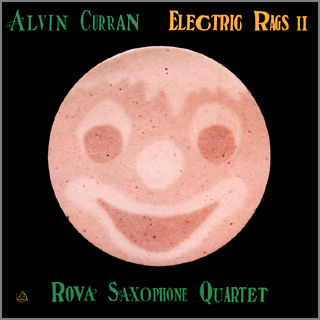
"wonder bread"
corny island (Ackley, unaccompanied solo)
general cluster
1. grandma's quilt 11:49
2. Z train 2:58
3. Little Him - Lo Main 2:43
4. Harmony Circus
corny island (Ochs, unaccompanied solo)
"dust bowl" 8:42
5. "scusami, I walk alone" 2:40
6. for Giacinto 3:40
7. "field it"
Jurassic times
corny island (Adams, unaccompanied solo)
List I[o=] 11:29
8. "cords of would" 3:03
9. "other brothers"
BLOW-HOLE
corny island (Raskin, unaccompanied solo)
continental shelf-dance 11:42
10. one and
amino acids
where in but out but 7:47
11. List I#
Jon Raskin: baritone and alto saxophones
Larry Ochs: tenor and sopranino saxophones
Steve Adams: alto and sopranino saxophones
Bruce Ackley: soprano saxophone
Expander: electronics
1990 - New Albion (USA) NA027 (CD)
Life on the Water Theater, San Francisco, CA, September, 1989
** All music published by Alvin Curran, S.I.A.E.
Electric Rags II consists of thirty sections, designed to be performed in a random
order. Of the sections, only "corny island," a section of structured improvisation,
is played more than once in any given performance. In this recording, the performance
consists of 23 sections, four of which are "corny island' for solo saxophone. Computer
design by Alvin Curran and realized by Nicola Bernardini. Electric Rags II was commissioned
by the Meet the Composer/Reader's Digest Commissioning Fund and the Atlanta Festival
of the Arts.
The music itself, like an experimental voyage, sets out to see what, if anything,
lies beyond "improvisation." To this end both determinate and indeterminate notations
are employed together with a special interactive system, which can reproduce electronically
anything the players playÑas they play it, or any time after, and in some
cases even before.
The heart of the piece is a computerized electronic system enabling each player
to pilot one or more Midi synthesizers directly from his own instrument. A flexible
computer program "conducts" or spontaneously structures the concert, which in spite
of formally notated sections or the highly conditioned improvisational tendencies
of the players, produces an ever new version of the work with each performance.
The computer further effects a number of rich musical transformations in real and
deferred time of whatever is played. Hundreds of colors and quasi-instrumental sounds
are constantly "orchestrated" by the system. The individual players are obliged
not only to react to one another and to the products of decisions made beyond their
will, but are made to listen to their own playing in quite a new way, since every
note they play may end up going anywhere...
-- Alvin Curran
ALVIN CURRAN
is a composer-performer of instrumental, electronic, and environmental music familiar
to New Music audiences throughout Europe and the United States. His musical invention
centers around his use of architecture and geography as natural musical theaters,
and his use of all sounding phenomena as music. The combination of these concepts
with instrumental and electronic sounds has produced works such as "Monumenti" (1982)
for mixed chorus, 25 trombones, 10 brass drums and Musica Elettronica Viva. "1985ÑA
Piece for Peace" reproposes radio as a great musical instrument: choruses, bands
and soloists in Holland, Germany, and Italy perform simultaneously. "Waterworks,"
a concert for ship's horns, brass bands, and fireworks, has been heard in five European
ports and at the opening of the 1987 New Music America Festival in Philadelphia.
In contrast to this "environmental" works stands a large body of compositions for
acoustic piano. Curran is a two-time NEA grantee and recipient of the D.A.A.D. prize
in Berlin. Mr. Curran lives in Rome.
ROVA SAXOPHONE QUARTET
now in its thirteenth year as a performing ensemble, has composed and performed
in the United States and abroad over sixty original works for saxophone quartet.
In addition, the group is noted for its PreEchoes concert series, which is used
as a laboratory for collaborative work with composers and musicians from all over
the United States. The recipients of numerous grants and awards, ROVA received the
"Best Concert of the Year" award from San Francisco Magazine for its July 1988 collaborative
performance with Anthony Braxton, a five-star rating in Downbeat magazine for its
1988 release, Beat Kennel (Black Saint 120 126-1), and inclusion in the San Francisco
Bay Guardian's top ten pop and jazz albums for 1988 for the Anthony Braxton-ROVA
recording, The Aggregate (Sound Aspects SAS 023). Its 1986 release, The Crowd (hatArt
2032), was named by Wire Magazine (England) as one of the top 50 LPs of the 1980's.